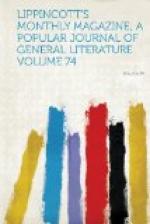stroll along the lawn-fence. Her ways are not
as the ways of other wrens. She has a somewhat
different style of diving into the ivy and exploring
the syringa. A new generation of doves has grown
up since the lilacs were in bloom, and nothing is easier
than to distinguish the old and young of the two or
three separate families till all leave the grass and
the gravel together and hie to the stubble-fields
beyond our ken. Of the one mocking bird who made
night hideous by his masterly imitations of the screaking
of a wheel-barrow (regreased at an early period in
self-defence) and the wheezy bark of Beppo, the superannuated
St. Bernard, there could of course be no doubt.
There was none of his kind to compare him with—not
even a mate, for “sexual selection” could
not possibly operate in face of so inharmonious a
love-song. His isolation had its parallel in the
one white guinea-fowl that haunted the shrubbery like
a ghost, much more silent and placid than it would
have been in society, and its antitype in the hennery,
where individuality of course ran riot among the Brahmas,
Dominicas and Hamburgs—hens that would
and would not lay, that would and would not set, that
would and would not scratch up seeds, and presented
generally as great a variety of vagaries as of feathers.
So, when we turned our back at last on lovely Boscobel,
itself shut out, as the common phrase goes, “from
the world” by serried ramparts of maple, elm,
acacia and catalpa, we knew well that that enceinte
of leafage enclosed many little worlds of its own—winged
microcosms, epicycles of the grand cycle of dateless
life which man in his humility assumes to be merely
a subsidiary appendage of his own orbit.
Birds should be studied seriously. The naturalists
will tell us more about them, and interest us more,
than the poets. Mr. Bryant makes fun of the bobolink,
and turns into an aimless whistle the solemn oration
on domestic matters uttered by that small but energetic
American to his mate. The waterfowl he treats
more gravely and respectfully, but he still makes it
only a part of the landscape and the theme, without
ascribing any intelligent purpose to its flight.
The bird, proceeding steadily and calmly to its business,
may well have confounded its versifier with his fellow
the fowler, and looked upon him, too, as regretting
only that it was out of gunshot. Audubon or Wilson
would have noted more sensibly the floating figure,
far above “falling dew,” and the earth-bound
mortal who was evidently afraid of rheumatics and
calculating whether he could walk home before dark.
The bird, they would have been perfectly aware, was
neither “wandering” nor “lost,”
and no more in need of the special interposition of
a protecting Providence than they or Mr. Bryant.
They would infer its motives, its point of departure
and its destination, the character of the friends
it left behind or sought—whether it was
carrying out a plan of the day or bound on an expedition
covering half the year. Its species would have




